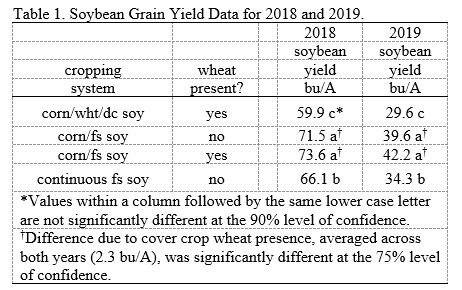Soil Health Benefit from Winter Wheat in the Rotation
By John Grove and Mark Coyne, University of Kentucky Research and Education Center
INTRODUCTION
This work is intended to answer the question: Are there long term soil health benefits to having wheat in Kentucky farmers’ crop rotation? Comparing wheat harvested for yield to wheat (or other small grain) as a cover crop, is it better for the soil to take wheat to grain harvest? The soil health impacts of wheat insertion in a grain crop rotation are being evaluated in the context of a long-term rotation study. In that study, corn/wheat/double crop soybean, continuous corn, continuous soybean (full season), and corn/corn/soybean/soybean (full season) are grown such that all parts of each rotation are represented each year. Until last fall, no cover crops were used – wheat was grown for grain. The study was changed by inserting a wheat cover crop in one-half of each plot transitioning between the corn and soybean in the corn/corn/soybean/soybean rotation. To meet the experimental objectives, the main plot treatments are: 1) corn/wheat (grain)/double crop soybean; 2) corn/wheat cover crop/full season soybean; and 3) corn/no wheat cover crop/full season soybean. The sub-plot treatments are three rates of fertilizer N applied to the previous corn crop.
PROCEDURES
Soil health assessment will include both conventional soil chemical property testing (pH, organic matter, total N, plant available P, K, Ca, Mg, and Zn) and mineralizable/active C and N. Other tests would assess changes in soil physical (penetration resistance (PR), wet aggregate stability) and biological (soil respiration; microbial biomass, activity and diversity) properties. More than one soil sampling event was needed to determine whether or not a change in a soil property – soil health parameter due to wheat insertion has occurred. The first sampling was done at wheat greenup. Another set of soil samples was taken when the cover crop wheat was terminated for full season soybean establishment. Finally, a third set of soil samples will be taken just after soybean (both double crop and full season) harvest.
RESULTS
Soybean grain yield data for both years of the study are presented just below (Table 1). Soybean yield responded to crop rotation, with double crop soybean yielding least and full season soybean following corn yielding the most. Full season soybean following corn yielded more when a wheat cover crop was planted after corn, but the yield benefit was small (+2.3 bu/A).
Following Table 1 is Table 2, which contains data from one of the soil health measurements, an assessment of soil urease activity under well controlled laboratory conditions. The measurement was done on surface (0 to 4-inch depth) soil samples taken in late May of 2019, after soybean emergence. The cover crop wheat was chemically terminated. Wheat in the double crop system was fully headed and in early grainfill. The urease enzyme activity was highest in soil taken from the corn/full season soybean rotation, regardless of cover crop absence/presence. Residues from the previous corn crop were sufficient to cause greater urease activity, and the presence of the cover crop did little to further stimulate activity. However, in the corn/wheat/double crop soybean rotation, where urease activity was generally lower, that urease activity was negatively related to the wheat applied N rate. This may be due, in part, to the fact that the wheat N source was Super U, which is urea co-prilled with NBPT, a urease inhibitor.
CONCLUSIONS
The soybean yield results are consistent – across both moist and dry seasons. The early soil health results are mixed, and additional soil health measurements need to be completed to more fully evaluate the hypotheses. We do have differences in the first of our data, and those differences can be explained. We will make an additional report after the rest of the data come in. A no-cost extension of the grant to fund acquisition of those data has been requested.
This is all lab work that should be completed by the end of the spring semester, May 2020.
ACKNOWLEDGEMENT
This research was funded by the Kentucky Small Grain Growers Association.


